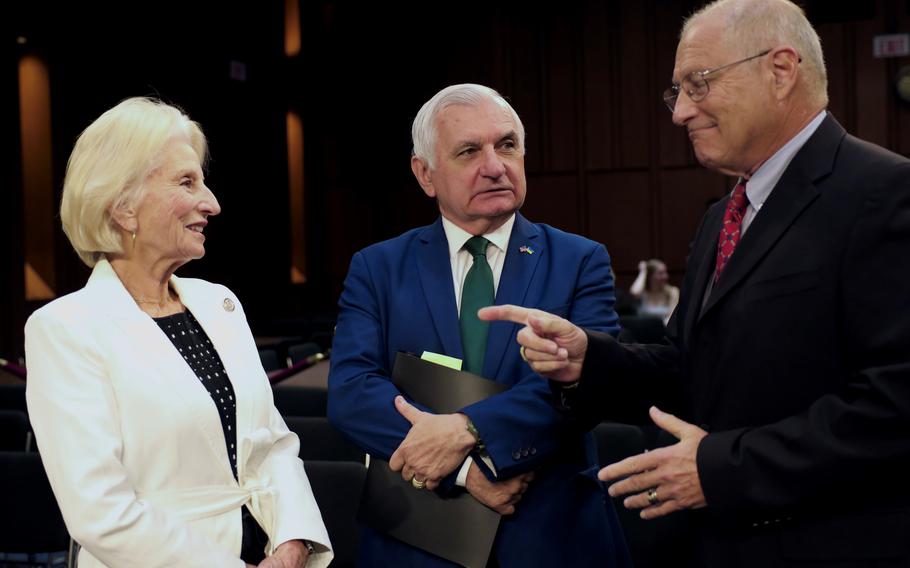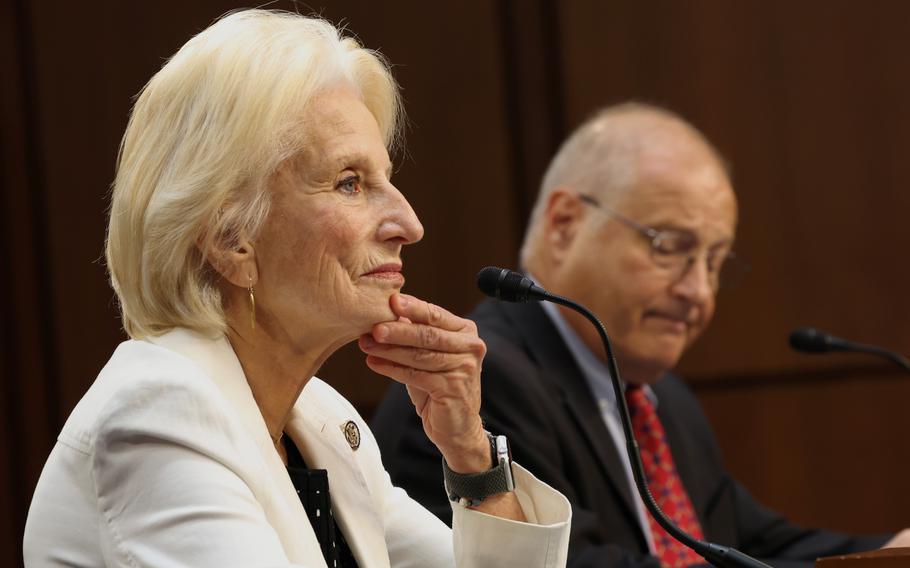
Jane Harman, left, chairwoman of the Commission on the National Defense Strategy, and Eric Edelman, vice chairman of the commission, right, talk with Sen. Jack Reed, D-R.I., chairman of the Senate Armed Services Committee, before a hearing Tuesday, July 30, 2024, on Capitol Hill. (Joe Gromelski/Special to Stars and Stripes)
WASHINGTON — The United States would need to increase its defense spending to Cold War-era levels to challenge threats around the world as China, Russia, North Korea and Iran foster an alliance that could lead to global war, according to a congressional commission formed to examine the national defense strategy.
“Where this goes, it seems to me, is terrifying. That is, again, why we need to leverage all elements of national power to make sure we deter these countries from acting against us,” Jane Harman, chairwoman of the Commission on the National Defense Strategy, said Tuesday during a hearing before the Senate Armed Services Committee.
The commission recommended in a 132-page report released Monday that the U.S. overhaul its national defense strategy and $900 billion defense budget to address recruiting failures, a “grossly inadequate” industrial base, and underfunded cyber and space domains. The commission was tasked by Congress with analyzing the 2022 defense strategy, which was written prior to Russia’s 2022 invasion of Ukraine and the evolution of the strategic partnership between China, Russia, Iran, and North Korea.
“There is potential for near-term war and a potential that we might lose such a conflict,” Eric Edelman, vice chairman of the Commission on the National Defense Strategy, told senators.
The U.S. has failed to keep pace with China and Russia, according to the report. The global economic damage from a Chinese blockade of Taiwan has been estimated to cost $5 trillion. An all-out war, the report read, would be more costly.
“We are optimized to fight very short wars,” Edelman said.
The commission endorsed its 2018 recommendation to increase base defense spending by 3 to 5% annually above inflation. That has not been consistently achieved. In recent years, the U.S. has dedicated about 3% of its global gross domestic product, which is a measure of economic growth reflecting the total value of goods and services produced in a country.
A return to post-Cold War-era defense spending would mean upping the defense spending budget to about 5% of the U.S. global gross domestic product. During the Cold War, U.S. defense spending ranged between 4.9% and 16.9%.
The report described the U.S. military as being “at its breaking point,” stating a multi-theater war that could be on the horizon could overwhelm the active-duty force. If the U.S. were to face a “worst-case scenario” global conflict, it would require a national mobilization not seen since World War II.
“We haven’t thought about that in a long time. There are a lot of elements to it — including stockpiling strategic materials — but being able to rapidly bring people into the military, I just don’t think we’re prepared to do it,” Edelman said.
The size of China’s forces has surpassed the U.S. military. China also continues to modernize its forces, investing upwards of $700 billion in defense spending, which is approaching Washington’s nearly $900 billion.
“While we still have the strongest military in the world with the farthest global reach, when we get to 1,000 miles off China’s shore, we start to lose our military dominance and could find ourselves on the losing end of a conflict,” Edelman said.

Jane Harman, left, chairwoman of the Commission on the National Defense Strategy, listens Tuesday, July 30, 2024, during a hearing of the Senate Armed Services Committee on Capitol Hill. Next to her is Eric Edelman, the commission’s vice chairman. (Joe Gromelski/Special to Stars and Stripes)
A regional conflict with China, the commission said, is likely to become a global war quickly as an alliance has been forged between China, Russia, North Korea and Iran in the wake of Russia’s invasion of Ukraine.
China has provided machine tools and microelectronics that are critical to Russian military manufacturing, while Russia evades sanctions with energy sales to China. Iran and North Korea have provided missiles and drones to fuel Russian attacks on Ukraine. The report said it is unclear what Russia has given in return to those two countries.
Referring to it as an “unholy alliance,” Harman told senators that China, Russia and North Korea are nuclear countries, and Iran is working to develop nuclear weapons.
To prepare for a global war, the report pointed to a need for the government to work with the private technology sector to strengthen the industrial base and supply chains.
To address recruiting failures, the commission said it supports an urgent call to action for military service and civil service. Recent recruitment shortfalls have decreased the size of the Army, Air Force, and Navy, with only the Marine Corps and Space Force having met 2023 recruiting goals.
Sen. Joe Manchin, I-W.Va., asked why the commission did not address a potential military draft. Edelman said the commission focused on recruiting and retention efforts, doubling down on pushing the services to add new incentives for recruits and more flexible personnel systems to boost interest in military service among the eligible population.
“I hope you all would revisit that, if you will,” Manchin responded.
While a war in the Indo-Pacific region would be mainly a Navy and Air Force fight, Edelman said that fight would largely be supported by the Army.
But not all fights will come from the land, sea or air, the commission said. The U.S. is also in need of a technology-focused workforce and software to protect the U.S. from battles in space and cyberspace.
Sen. Angus King, I-Maine, inquired about the need for a national cyber defense strategy.
“There has to be a price to be paid for attacking this country in the realm of cyber,” he said.
Harman responded: “There are things we are doing that we can’t talk about that are deterring cyber against us.”
King interrupted her: “I am sorry but if you can’t talk about it, it is not deterrence.”
The push for cyber and space investments in the workforce comes as China has infiltrated critical infrastructure networks in the U.S. The commission said China also has the potential to disrupt power and water in the U.S.
“The homeland — if there is a conflict — is not going to be a sanctuary anymore,” Edelman said. “The first attacks will likely be in the cyber domain, and they will be incredibly disabling for our society.”